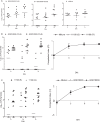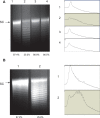A fluoroquinolone resistance associated mutation in gyrA Affects DNA supercoiling in Campylobacter jejuni
- PMID: 22919613
- PMCID: PMC3417464
- DOI: 10.3389/fcimb.2012.00021
A fluoroquinolone resistance associated mutation in gyrA Affects DNA supercoiling in Campylobacter jejuni
Abstract
The prevalence of fluoroquinolone (FQ)-resistant Campylobacter has become a concern for public health. To facilitate the control of FQ-resistant (FQ(R)) Campylobacter, it is necessary to understand the impact of FQ(R) on the fitness of Campylobacter in its natural hosts as understanding fitness will help to determine and predict the persistence of FQ(R)Campylobacter. Previously it was shown that acquisition of resistance to FQ antimicrobials enhanced the in vivo fitness of FQ(R)Campylobacter. In this study, we confirmed the role of the Thr-86-Ile mutation in GyrA in modulating Campylobacter fitness by reverting the mutation to the wild-type (WT) allele, which resulted in the loss of the fitness advantage. Additionally, we determined if the resistance-conferring GyrA mutations alter the enzymatic function of the DNA gyrase. Recombinant WT gyrase and mutant gyrases with three different types of mutations (Thr-86-Ile, Thr-86-Lys, and Asp-90-Asn), which are associated with FQ(R) in Campylobacter, were generated in E. coli and compared for their supercoiling activities using an in vitro assay. The mutant gyrase with the Thr-86-Ile change showed a greatly reduced supercoiling activity compared with the WT gyrase, while other mutant gyrases did not show an altered supercoiling. Furthermore, we measured DNA supercoiling within Campylobacter cells using a reporter plasmid. Consistent with the results from the in vitro supercoiling assay, the FQ(R) mutant carrying the Thr-86-Ile change in GyrA showed much less DNA supercoiling than the WT strain and the mutant strains carrying other mutations. Together, these results indicate that the Thr-86-Ile mutation, which is predominant in clinical FQ(R)Campylobacter, modulates DNA supercoiling homeostasis in FQ(R)Campylobacter.
Keywords: Campylobacter; DNA supercoiling; GyrA mutation; fitness; fluoroquinolone resistance.
Figures




Similar articles
-
Droplet Digital PCR-Based Detection and Quantification of GyrA Thr-86-Ile Mutation Based Fluoroquinolone-Resistant Campylobacter jejuni.Microbiol Spectr. 2022 Apr 27;10(2):e0276921. doi: 10.1128/spectrum.02769-21. Epub 2022 Apr 12. Microbiol Spectr. 2022. PMID: 35412390 Free PMC article.
-
Enhanced in vivo fitness of fluoroquinolone-resistant Campylobacter jejuni in the absence of antibiotic selection pressure.Proc Natl Acad Sci U S A. 2005 Jan 18;102(3):541-6. doi: 10.1073/pnas.0408966102. Epub 2005 Jan 5. Proc Natl Acad Sci U S A. 2005. PMID: 15634738 Free PMC article.
-
Characterization of DNA Gyrase Activity and Elucidation of the Impact of Amino Acid Substitution in GyrA on Fluoroquinolone Resistance in Mycobacterium avium.Microbiol Spectr. 2023 Jun 15;11(3):e0508822. doi: 10.1128/spectrum.05088-22. Epub 2023 Apr 17. Microbiol Spectr. 2023. PMID: 37067420 Free PMC article.
-
Fluoroquinolone-resistant Campylobacter in animal reservoirs: dynamics of development, resistance mechanisms and ecological fitness.Anim Health Res Rev. 2003 Dec;4(2):63-71. doi: 10.1079/ahr200356. Anim Health Res Rev. 2003. PMID: 15134291 Review.
-
The Molecular Genetics of Fluoroquinolone Resistance in Mycobacterium tuberculosis.Microbiol Spectr. 2014 Aug;2(4):MGM2-0009-2013. doi: 10.1128/microbiolspec.MGM2-0009-2013. Microbiol Spectr. 2014. PMID: 26104201 Review.
Cited by
-
Genetic Basis and Functional Consequences of Differential Expression of the CmeABC Efflux Pump in Campylobacter jejuni Isolates.PLoS One. 2015 Jul 1;10(7):e0131534. doi: 10.1371/journal.pone.0131534. eCollection 2015. PLoS One. 2015. PMID: 26132196 Free PMC article.
-
Antimicrobial Use and Antimicrobial Resistance Indicators-Integration of Farm-Level Surveillance Data From Broiler Chickens and Turkeys in British Columbia, Canada.Front Vet Sci. 2019 May 3;6:131. doi: 10.3389/fvets.2019.00131. eCollection 2019. Front Vet Sci. 2019. PMID: 31131285 Free PMC article.
-
The Global Challenge of Campylobacter: Antimicrobial Resistance and Emerging Intervention Strategies.Trop Med Infect Dis. 2025 Jan 16;10(1):25. doi: 10.3390/tropicalmed10010025. Trop Med Infect Dis. 2025. PMID: 39852676 Free PMC article. Review.
-
Genome sequences of antimicrobial-resistant Campylobacter coli and Campylobacter jejuni, isolated from poultry in Ukraine.Microbiol Resour Announc. 2024 Dec 12;13(12):e0079524. doi: 10.1128/mra.00795-24. Epub 2024 Nov 21. Microbiol Resour Announc. 2024. PMID: 39570027 Free PMC article.
-
Genomic diversity of Campylobacter jejuni and Campylobacter coli isolated from the Ethiopian dairy supply chain.PLoS One. 2024 Aug 19;19(8):e0305581. doi: 10.1371/journal.pone.0305581. eCollection 2024. PLoS One. 2024. PMID: 39159178 Free PMC article.
References
Publication types
MeSH terms
Substances
Grants and funding
LinkOut - more resources
Full Text Sources
Medical
Molecular Biology Databases

